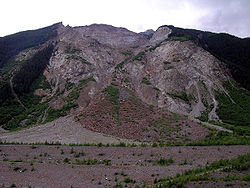
Val Pola landslide
Encyclopedia


Valtellina
Valtellina or the Valtelline valley ; is a valley in the Lombardy region of northern Italy, bordering Switzerland. Today it is known for its skiing, its hot spring spas, its cheeses and its wines...
, Lombardy
Lombardy
Lombardy is one of the 20 regions of Italy. The capital is Milan. One-sixth of Italy's population lives in Lombardy and about one fifth of Italy's GDP is produced in this region, making it the most populous and richest region in the country and one of the richest in the whole of Europe...
, Northern Italian Alps, on July 28, 1987 and resulted in the Valtellina disaster
Valtellina disaster
The Valtellina disaster happened in Valtellina, Northern Italian Alps, in July-August 1987. The calamity affected the provinces of Sondrio, Brescia, Bergamo, Lecco, and Como....
(destruction of villages, road closure, floodability
Floodability
Floodability may refer to one of the following.*Floodability , a characteristic of the construction of a ship to resist flooding.*Floodability of powderized materials, its tendency to liquid-like flow due to natural fluidization of a mass of particles by air .*The risk of flooding of land areas or...
threat) with the total cost of 400 million euro
Euro
The euro is the official currency of the eurozone: 17 of the 27 member states of the European Union. It is also the currency used by the Institutions of the European Union. The eurozone consists of Austria, Belgium, Cyprus, Estonia, Finland, France, Germany, Greece, Ireland, Italy, Luxembourg,...
s.
In June-July 1987, Valtellina witnessed and exceptionally high rainfall accompanied with rapid glacier
Glacier
A glacier is a large persistent body of ice that forms where the accumulation of snow exceeds its ablation over many years, often centuries. At least 0.1 km² in area and 50 m thick, but often much larger, a glacier slowly deforms and flows due to stresses induced by its weight...
melting due to relatively high altitude of the 0 degree isotherm. As a result the Val Pola Creek significantly eroded its valley flanks, including the area of debris accumulation of post-glacial landslides. This resulted in a fracture which detached an estimated volume 35-45 million cubic metres of old debris from the Northern slope of the Mount Zandila (Eastern side of Pizzo Coppetto) first detected on July 25. On July 26 evacuations of local villages started. The fracture eventually produced a rapid rock avalanche with subsequent shallow landslides of the Val Pola sides and a debris flow
Debris flow
A debris flow is a fast moving, liquefied landslide of unconsolidated, saturated debris that looks like flowing concrete. It is differentiated from a mudflow in terms of the viscosity and textural properties of the flow. Flows can carry material ranging in size from clay to boulders, and may...
along the Val Pola thalweg
Thalweg
Thalweg in geography and fluvial geomorphology signifies the deepest continuous inline within a valley or watercourse system.-Hydrology:In hydrological and fluvial landforms, the thalweg is a line drawn to join the lowest points along the entire length of a stream bed or valley in its downward...
. The flow entrained estimated 5-8 million cubic meters of debris. The created alluvial fan
Alluvial fan
An alluvial fan is a fan-shaped deposit formed where a fast flowing stream flattens, slows, and spreads typically at the exit of a canyon onto a flatter plain. A convergence of neighboring alluvial fans into a single apron of deposits against a slope is called a bajada, or compound alluvial...
dammed the Adda River
Adda River
The Adda is a river in North Italy, a tributary of the Po. It rises in the Alps near the border with Switzerland and flows through Lake Como. The Adda joins the Po a few kilometres upstream of Cremona. It is 313 kilometres long...
and created a lake. The mass run about 1.5 km downstream and generated an upstream mud wave 35m high which traveled about 2.7 km.
Twenty-two people were killed by the main landslide, which created a huge wave in the temporary lake caused by a previous, smaller landslide.
The landslide resulted in 35 m deepening of the Val Pola canyon.

